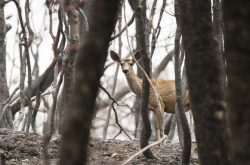
When a massive wildfire tears through a landscape, what happens to the animals?
While many animals have adapted to live with wildfires of the past — which were smaller, more frequent and kept ecosystems in balance across the West — it’s unclear to scientists how animals are coping with today’s unprecedented megafires. More than a century of fire suppression coupled with climate change has produced wildfires that are now bigger and more severe than before.
In a rare stroke of luck, researchers from the University of Washington, the University of California, Berkeley, and the University of California, Santa Barbara, were able to track a group of black-tailed deer during and after California’s third-largest wildfire, the 2018 Mendocino Complex Fire. The megafire, which torched more than 450,000 acres in northern California, burned across half of an established study site, making it possible to record the movements and feeding patterns of deer before, during and after the fire. The results were published Oct. 28 in the journal Ecology and Evolution.
The researchers were surprised by what they learned. Of the 18 deer studied, all survived. Deer that had to flee the flames returned home, despite some areas of the landscape being completely burned and void of vegetation to eat. Most of the deer returned home within hours of the fire, while trees were still smoldering.
Having access to this location information — from previously placed wildlife cameras and GPS collars — is rare when studying how animals respond to extreme and unpredictable events, like megafires.
“There are very few studies that aim to understand the short-term, immediate responses of animals to wildfires. When a fire sweeps through and dramatically changes the landscape, its impact in those initial days is undervalued and absent in the published literature,” said co-lead author Samantha Kreling, a doctoral student at the UW School of Environmental and Forest Sciences.
Read more at UW News »
